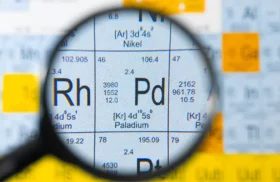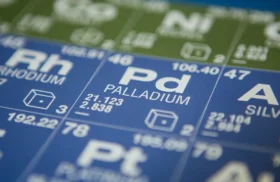
Central Asia Metals Raises Bid for New World Resources Central Asia Metals has increased its takeover offer for Australian copper developer New World Resources from A$185 million ($119 million) to approximately A$230 million ($130 million). The revised bid of A$0.062 per share represents a 24% increase from the company’s initial May proposal and comes as...
READ MORE
China Increases Imports of Copper Raw Materials In May, Chinese metallurgical companies imported 2.4 million tonnes of copper concentrates, marking a 5.8% increase over the same period last year. This growth brought total copper concentrate imports to 12.4 million tonnes for the first five months of 2025, a 7.4% rise compared to the previous year....
READ MORE
Constellium Joins Large-Scale Pentagon Programme The French metallurgical group Constellium has entered into an agreement with the American company Nikon Advanced Manufacturing and the public-private partnership America Makes to implement a project focused on the use of a specialized aluminium alloy in additive manufacturing. The initiative is geared towards applications within the US defense and...
READ MORE
Platinum and palladium are platinum group metals (PGM), a classification which also includes iridium, osmium, rhodium and ruthenium. Both metals are highly valued for their rarity, durability and wide-ranging applications, which makes them particularly important in the automotive industry, jewellery making and clean energy. Today, the importance of these metals to global markets is growing,...
READ MORE
The discovery of palladium and its early uses Palladium is one of the rarest and most valuable metals on the planet – it’s 30 times more scarce than gold. The history of this metal begins in 1802, when English chemist William Hyde Wollaston discovered a new substance while dissolving platinum in a mixture of nitric...
READ MORE
Hydrogen is emerging as a promising alternative fuel for the transportation and energy sectors due to its clean-burning property and high energy density. “Green” hydrogen, produced using renewable energy sources, is particularly attractive as it has the potential to significantly reduce greenhouse gas emissions. One of the key technologies for the production of green hydrogen...
READ MORE
Lithium foil and copper foil for battery use are seeing substantial growth, driven by the rising needs from electric vehicles and energy storage systems. Key parameters like the foil’s thickness, conductivity, and the manufacturing technology used form the building blocks of this evolving supply chain. Materials and types overview The foil market is composed of...
READ MORE
The physical and chemical properties of aluminium Aluminium is one of the most versatile substances used in modern industry, valued for its light weight, malleability, resistance to corrosion, and conductivity of heat. Having the density value of only 2.7 g/cm³, aluminium is about one-third lighter than steel, hence making it especially suitable in applications where...
READ MORE
Composition of palladium white gold White gold palladium is an alloy created from the blending of pure gold with the platinum group metal palladium. The standard alloy is 75% gold (18K) with 10–25% palladium, with traces of silver or copper sometimes added in for workability. Unlike the use of nickel as decolorizer in routine white...
READ MORE
Emirates Global Aluminium to Increase Solar Aluminium Supplies Emirates Global Aluminium (EGA) has deepened its long-standing relationship with Hyundai Mobis, the major South Korean automotive components manufacturer, by signing a new agreement to significantly increase the supply of its CelestiAL brand solar-powered aluminium. The new agreement is a continuation of their collaboration, reflecting a mutual...
READ MORE
Deep-Sea Mining Attracts Investor Interest The Metals Company, a US-based firm, conducted a presentation showcasing ore samples extracted from 4-kilometer depths in international waters. The event drew representatives from major global non-ferrous metals companies, including Mitsubishi, Glencore, and Panasonic Energy. The samples demonstrated high concentrations of nickel, cobalt, and copper, highlighting the potential of deep-sea...
READ MORE
Transition Elements Plans Lithium Exploration in Southern France Transition Elements, a Norwegian company, has submitted an application to the prefecture of the Hérault department in southern France for an exclusive license to explore and prospect for lithium deposits. The company’s proposal covers a 218-square-kilometer area, where it intends to conduct a multi-phase geological exploration program....
READ MORE
Physical and Chemical Properties of Palladium Palladium (Pd) is a lustrous, silver-white metal belonging to the platinum group metals (PGMs). It is renowned for its high catalytic activity, chemical inertness, and exceptional ability to absorb hydrogen, which makes it highly valuable across numerous advanced technologies. Key physical and chemical properties include: Its unique ability to...
READ MORE
Physical and Chemical Properties of Palladium Palladium (Pd) is a soft, silvery-white metal belonging to the platinum group metals (PGMs), widely valued for its catalytic properties, corrosion resistance, and hydrogen absorption capabilities. Key properties include: These attributes make palladium essential across a variety of cutting-edge technologies and scientific applications. Synthesis Methods of Palladium Nanoparticles Palladium...
READ MORE
Ancient Origins and Historical Milestones Copper is one of the oldest metals known to humanity. Archaeological evidence shows that it was used over 10,000 years ago. The Çatalhöyük settlement in modern-day Turkey, dating back to around 7500 BCE, contains some of the earliest examples of copper tools. During the Bronze Age, copper was alloyed with...
READ MORE
Unique Physical and Chemical Properties Nickel is a lustrous, silver-white metal known for its magnetism, durability, and corrosion resistance. It is one of only a few elements that is ferromagnetic at room temperature, making it valuable in a wide range of magnetic and electronic applications. Key characteristics of nickel include: Because of its mechanical strength...
READ MORE
Rio Tinto and Indium Corporation Progress with Gallium Project in Canada Rio Tinto, working in collaboration with Indium Corporation, has completed the first phase of a research initiative aimed at producing gallium, a rare metal. The companies have successfully produced a pilot batch of gallium, marking a key milestone in the project. The next phase...
READ MORE
Unique Physical and Chemical Properties Platinum is a dense, silvery-white metal that stands out for its remarkablea chemical stability, corrosion resistance, and high melting point of 1,768°C (3,214°F). It is part of the platinum group metals (PGMs), known for their catalytic properties and durability. What makes platinum truly unique: These qualities explain why platinum is...
READ MORE
Nickel’s Role in EV Battery Technology Nickel plays a critical role in modern electric vehicle (EV) batteries, particularly in lithium-ion chemistries such as nickel-manganese-cobalt (NMC) and nickel-cobalt-aluminum (NCA). These nickel-rich cathodes are central to achieving higher energy density, which translates to longer driving ranges and better performance for EVs. In battery cells, nickel contributes to...
READ MORE
Synthesis Methods of Platinum Nanoparticles Platinum nanoparticles (PtNPs) can be synthesized through a variety of chemical, physical, and biological approaches, each offering specific advantages in terms of particle size, shape, and stability. 1. Chemical Reduction Methods This is the most common approach, where platinum salts (e.g., H₂PtCl₆) are reduced using agents like sodium borohydride, hydrazine,...
READ MORE
Physical and chemical properties Platinum and palladium are both members of the platinum group metals (PGMs), sharing several characteristics such as resistance to corrosion and high melting points. However, there are key differences in their physical and chemical profiles: Understanding these physical differences is essential when choosing between platinum vs palladium for either durability or...
READ MORE
Global Copper Surplus to Persist Through 2026 Global refined copper production is projected to increase by 2.9% in 2025, reaching 28.9 million tonnes, according to the International Copper Study Group. The rise is attributed to growing output in China and the commissioning of new facilities in countries including Indonesia, India and the Democratic Republic of...
READ MORE
Lyten Launches All-American Lithium Foil Production Lyten, a US-based developer of lithium-sulphur batteries, has produced a pilot batch of lithium foil using exclusively domestic raw materials. The company has fully localised the supply chain for materials used in sulphur cathodes and is now replicating this achievement for lithium anodes. This strategy eliminates dependence on foreign...
READ MORE
Indonesia changes taxation on mineral extraction The Indonesian government has introduced a new approach to mineral extraction taxation, now tying royalty rates to market prices. This system, which is expected to come into force soon, replaces the previous fixed rate for nickel ore mining with a sliding scale ranging from 14% to 19%, depending on...
READ MORE























